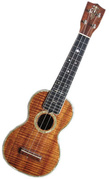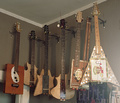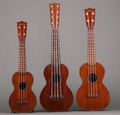Today’s guest blogger is Andy Roth, who was interviewed by Collectors Weekly in June of 2010. Andy can be reached at andyroth@comcast.net.
“Otto Kamm???”
No, that’s not what I said! I said, “Ah Tau Kam.” Who is that, you ask? Well, very little is known about him and I could find only a couple references to him on the Internet (now, there is one more). According to the Kamaka Ukulele website, Ah Tau Kam was a contemporary of Samuel Kamaka Sr. (1890-1953) back in the day when Sam Sr. was just starting out. According to the Ukulele Hall of Fame Museum, Ah Tau Kam was one of Samuel Kamaka’s mentors, along with Jonah Kumalae and Sam Chang, both of whom helped Sam Sr. learn the craft of making ukuleles. Inasmuch as Kumalae appeared in the Honolulu City directories as early as 1911, we might guess that the mysterious Ah Tau Kam might have been making ukuleles around that time.
The ukulele pictured here features some extraordinary flame-like quilted koa wood and a wide band of abalone shell inlay next to the white binding on the top, around the sound hole and in the fret position markers. The ornate and elaborate inlay combined with the fancy headstock make it a striking instrument, and it sounds great. For a soprano, it has a wide waist and a large body, similar in shape to some Paul Summers and Sam Chang instruments. The maker’s name appears in the gold decal on the headstock, and it sports the “Tabu” branded stamp on back of the headstock.The item inside the sound hole is a strangely oversized cleat bracing a tightly closed back crack repair.
The following is information I received from the Hawaiian family from whom I purchased this instrument: “According to the seller, Ah Tau Kam taught the Kamakas to make ukuleles. Then, sometime in the 1920s, Kam found himself in difficult financial ways. In need of dental work, he went to Joseph Pekelo, supposedly the first certified dentist west of the Rockies (the dentist’s wife was a great aunt to the person who sold me the instrument). Kam gave Pekelo this ukulele as partial payment for the dental work he had received. Pekelo kept the uke and, through the years, played it at the occasional luaus and barbecues he attended. When he passed away, the ukulele had been in his closet for many years, and it had been passed down from generation to generation until sold to me. The back crack was believed to have been caused by gut strings being kept too taut, and the repairs were purportedly done by the Kamakas themselves.”
Rarely do we get this kind of detailed history and provenance of an instrument. I hope it’s all accurate; it sure was fun to hear, and I hope you enjoyed it too!



 The Blues Rocker's New Secret Weapon? An Electric Cigar Box Guitar
The Blues Rocker's New Secret Weapon? An Electric Cigar Box Guitar
 Ukulele Collector Andy Roth: An Interview with Collectors Weekly
Ukulele Collector Andy Roth: An Interview with Collectors Weekly The Blues Rocker's New Secret Weapon? An Electric Cigar Box Guitar
The Blues Rocker's New Secret Weapon? An Electric Cigar Box Guitar Great Guitars: The Origins of the Concert Uke
Great Guitars: The Origins of the Concert Uke UkulelesJust about every major guitar maker has produced a ukulele (often misspelle…
UkulelesJust about every major guitar maker has produced a ukulele (often misspelle… Mari Tepper: Laying it on the Line
Mari Tepper: Laying it on the Line Nice Ice: Valerie Hammond on the Genteel Charm of Vintage Canadian Costume Jewelry
Nice Ice: Valerie Hammond on the Genteel Charm of Vintage Canadian Costume Jewelry How Jim Heimann Got Crazy for California Architecture
How Jim Heimann Got Crazy for California Architecture Modernist Man: Jock Peters May Be the Most Influential Architect You've Never Heard Of
Modernist Man: Jock Peters May Be the Most Influential Architect You've Never Heard Of Meet Cute: Were Kokeshi Dolls the Models for Hello Kitty, Pokemon, and Be@rbrick?
Meet Cute: Were Kokeshi Dolls the Models for Hello Kitty, Pokemon, and Be@rbrick? When the King of Comedy Posters Set His Surreal Sights on the World of Rock 'n' Roll
When the King of Comedy Posters Set His Surreal Sights on the World of Rock 'n' Roll How One Artist Makes New Art From Old Coloring Books and Found Photos
How One Artist Makes New Art From Old Coloring Books and Found Photos Say Cheese! How Bad Photography Has Changed Our Definition of Good Pictures
Say Cheese! How Bad Photography Has Changed Our Definition of Good Pictures Middle Earthenware: One Family's Quest to Reclaim Its Place in British Pottery History
Middle Earthenware: One Family's Quest to Reclaim Its Place in British Pottery History Fancy Fowl: How an Evil Sea Captain and a Beloved Queen Made the World Crave KFC
Fancy Fowl: How an Evil Sea Captain and a Beloved Queen Made the World Crave KFC
I once read that ukulele was the American spelling, while ukelele was the British spelling. Never tried to check it out. Great article. Thanx.
Hi, I have a identical uke of your Ah Tau Kan uke on eBay up at magicbeanbuyer now. The interesting thing is a brass oval plate may cover the name because it was made for Paul Summers. Originally I thought it may be made by Leonardo Nunes because he is the only other one I found with headstocks shaped like this. There is a LNunes Baritone uke up like it now. Anyway I would appreciate your opinion. My husband is in his 80s and selling some of his ukes. Thanks for sharing, Della
I believe I have a Kam ukulele. it is my most prized possession, given to me by my father, in the late 1950s. I think he said he paid $35.00 having had it made for me. Wooden pegs and all, I know its sound. many years ago I was at the shopping center when that familiar sound quality drew me into Honolulu Music Store. A collection of ukes made by Cruz sounded like mine, the closest I ever heard then and since.